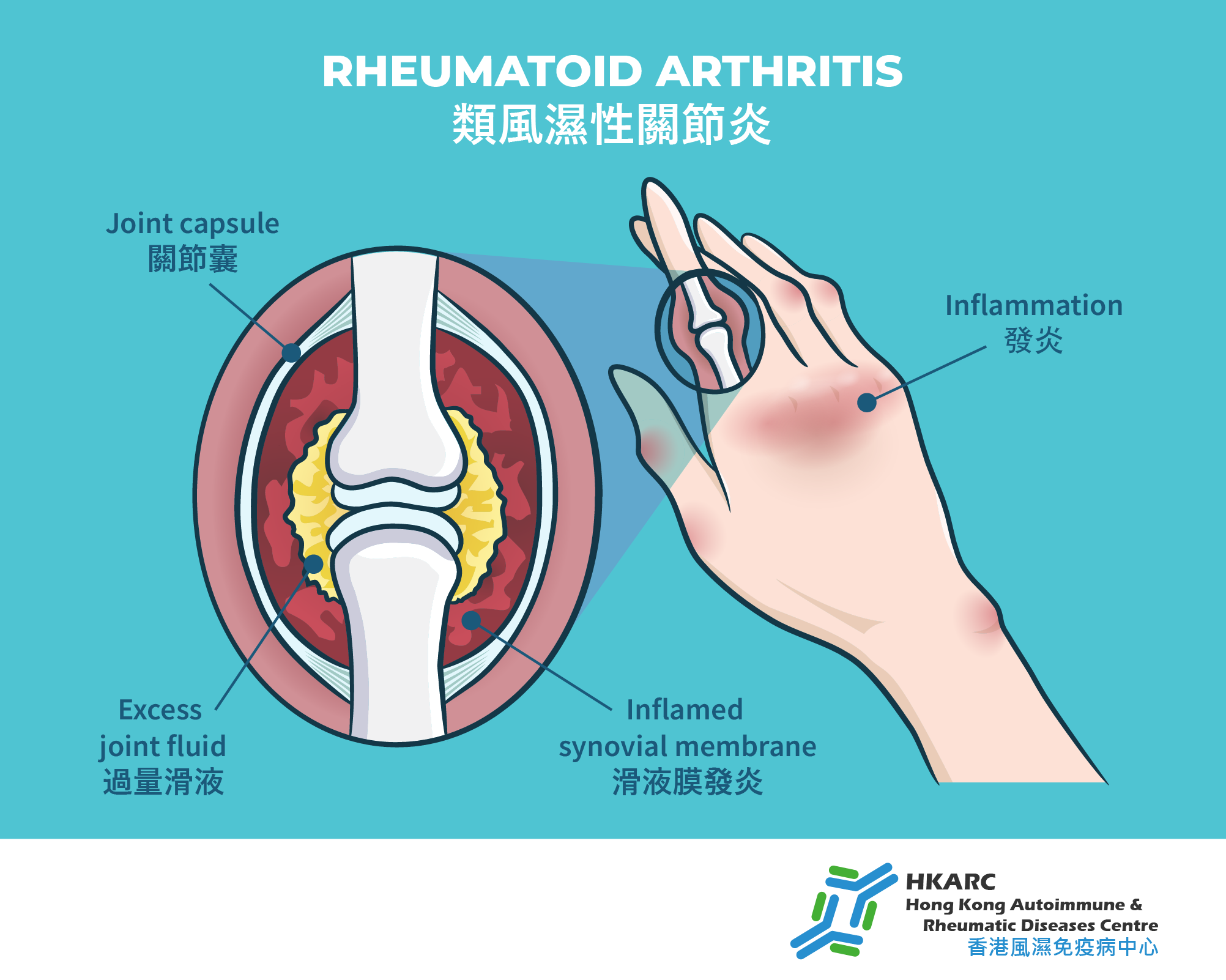What is Rheumatoid Arthritis?
Rheumatoid Arthritis (RA) is a chronic autoimmune disease caused by immune system dysfunction, leading the body to attack various joints. Approximately 1 in every 100 people is affected. It predominantly affects young to middle-aged women. The gender ratio is about 1:3 (female:male). The average age of onset is between 30 and 50 years old.
Causes of Rheumatoid Arthritis
Rheumatoid Arthritis is an autoimmune disease whose exact cause is not fully understood. It is generally believed to be related to genetic factors, environmental influences, and immune system dysregulation. The disease results from an immune system malfunction that causes the body to attack its own joints.
Symptoms of Rheumatoid Arthritis
Commonly affected joints include the wrists, finger joints, and knees. Patients often experience morning stiffness lasting over 30 minutes. Affected joints may become red, swollen, warm, and painful.
Other common symptoms include:
- Fatigue
- Loss of appetite
- Mild fever
- Dry eyes and lips
- Eye inflammation
Rheumatoid Arthritis can affect any joint, often involving both sides of the small finger joints, especially the distal interphalangeal joints. Other frequently affected joints include the wrists, elbows, shoulders, and knees. Patients commonly experience morning stiffness lasting over 30 minutes, which gradually improves with activity. Persistent joint inflammation can lead to bone erosion and even irreversible deformities. Beyond joints, RA may also be associated with other comorbidities such as pulmonary fibrosis and episcleritis. Patients also have a higher risk of osteoporosis.
If more than one joint is swollen and painful for over six weeks, especially involving the small finger joints at the distal end, early consultation with a rheumatologist is recommended to diagnose whether you have rheumatoid arthritis. Blood tests such as CRP and ESR (markers of inflammation), Rheumatoid Factor (RF), and Anti-CCP antibodies can assist in diagnosis. Imaging examinations like X-rays, ultrasound, and MRI can also help in confirming RA.
Treatment Methods
Early diagnosis and treatment are crucial for managing rheumatoid arthritis. Medications include conventional disease-modifying anti-rheumatic drugs (DMARDs) and biologics, which can significantly improve joint conditions. In particular, biologics are more effective in reducing joint structural damage.
Traditional DMARDs
Traditional DMARDs gradually replace steroids in controlling disease progression. They work by suppressing immune activity to reduce joint inflammation and destruction, alleviating symptoms such as pain, swelling, and stiffness, and slowing disease progression to help maintain joint function.
Biologics / Targeted Synthetic DMARDs
Biologics are antibody-based drugs developed through biotechnology. They specifically target and inhibit uncontrolled inflammatory cytokines within the body, thereby halting the cascade of inflammation caused by these mediators.
In rheumatology, biologics include Anti-TNF, Anti-IL6, Anti-IL17, Anti-IL23, and JAK inhibitors. These treatments effectively control moderate to severe disease, greatly improving patients’ quality of life and preventing long-term joint damage caused by inflammation.
Biologics have higher specificity and are more effective, with fewer side effects compared to traditional DMARDs.
Targeted Synthetic DMARDs Oral targeted synthetic DMARDs, such as JAK inhibitors, are a new class of drugs that are effective for various immune system diseases. They are convenient to take compared to injections.
FAQs
• What is Rheumatoid Factor?
Rheumatoid Factor (RF) is an autoantibody of the immunoglobulin class. About 60-70% of RA patients test positive for RF. While RF testing can aid in diagnosing rheumatoid arthritis, a high RF level does not definitively confirm the disease. Older adults or individuals with other conditions, such as hepatitis caused by viruses or tuberculosis, may also have positive RF results.
• What are the early symptoms of Rheumatoid Arthritis?
Early symptoms mainly include joint pain, stiffness, and swelling, especially after waking up or resting. The initial involvement often affects smaller joints, commonly the wrists and the first and second finger joints, typically appearing symmetrically and accompanied by pain, warmth, and swelling. Patients may also experience fatigue, loss of appetite, or weight loss.
• Is there an optimal window for treating Rheumatoid Arthritis?
Early diagnosis and treatment of RA are vital to achieving disease remission. Once joint erosion occurs, irreversible damage can ensue. The first one to two years after disease onset are considered the golden period for treatment. During this time, patients should work closely with their doctors to develop a treatment plan, adhere to prescribed medications, and utilize various pharmacological and non-pharmacological therapies to achieve disease control.

